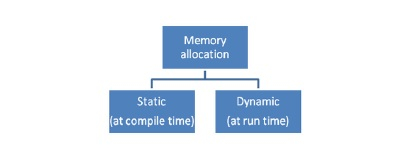C プログラミングにおいて、静的メモリ割り当てとは何を意味しますか?
- 王林転載
- 2023-09-14 15:21:011124ブラウズ
メモリは次の 2 つの方法で割り当てられます。

静的メモリ割り当て
静的変数は、固定サイズの割り当てられたスペース ブロックで定義されます。 。一度割り当てられると解放することはできません。
プログラム内で宣言された変数にメモリを割り当てます。
「&」演算子を使用してアドレスを取得し、それをポインターに割り当てることができます。
メモリはコンパイル時に割り当てられます。
スタックを使用してメモリの静的割り当てを維持します。
この種の割り当てでは、メモリが割り当てられると、メモリ サイズを変更できません。
- #効率が低い。
#include<stdio.h>
main (){
int a[5] = {10,20,30,40,50};
int i;
printf (“Elements of the array are”);
for ( i=0; i<5; i++)
printf (“%d, a[i]);
}出力Elements of the array are
1020304050
例 2配列を計算する別の例を考えてみましょう。 − リアルタイム デモンストレーション#include<stdio.h>
void main(){
//Declaring the array - run time//
int array[5]={10,20,30,40,50};
int i,sum=0,product=1;
//Reading elements into the array//
//For loop//
for(i=0;i<5;i++){
//Calculating sum and product, printing output//
sum=sum+array[i];
product=product*array[i];
}
//Displaying sum and product//
printf("Sum of elements in the array is : %d</p><p>",sum);
printf("Product of elements in the array is : %d</p><p>",product);
}出力Sum of elements in the array is : 150
Product of elements in the array is : 12000000
のすべての要素の合計と積以上がC プログラミングにおいて、静的メモリ割り当てとは何を意味しますか?の詳細内容です。詳細については、PHP 中国語 Web サイトの他の関連記事を参照してください。
声明:
この記事はtutorialspoint.comで複製されています。侵害がある場合は、admin@php.cn までご連絡ください。
前の記事:C 言語では、構造体の変数配列メンバー次の記事:C 言語では、構造体の変数配列メンバー

